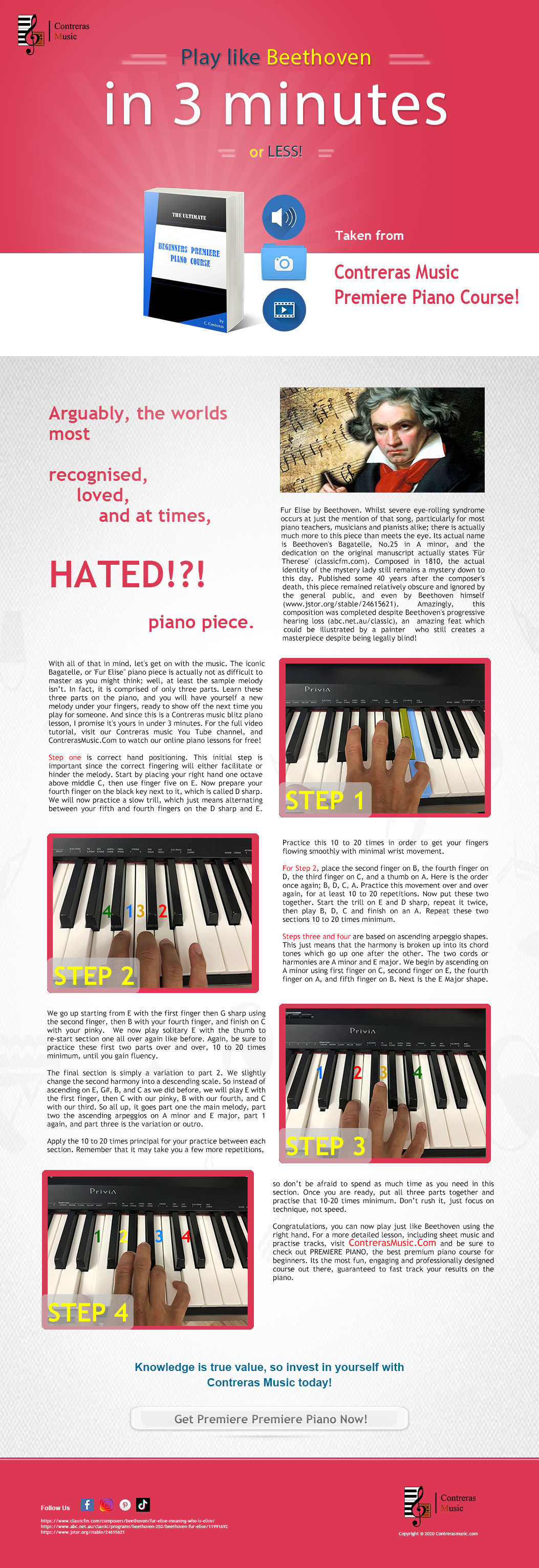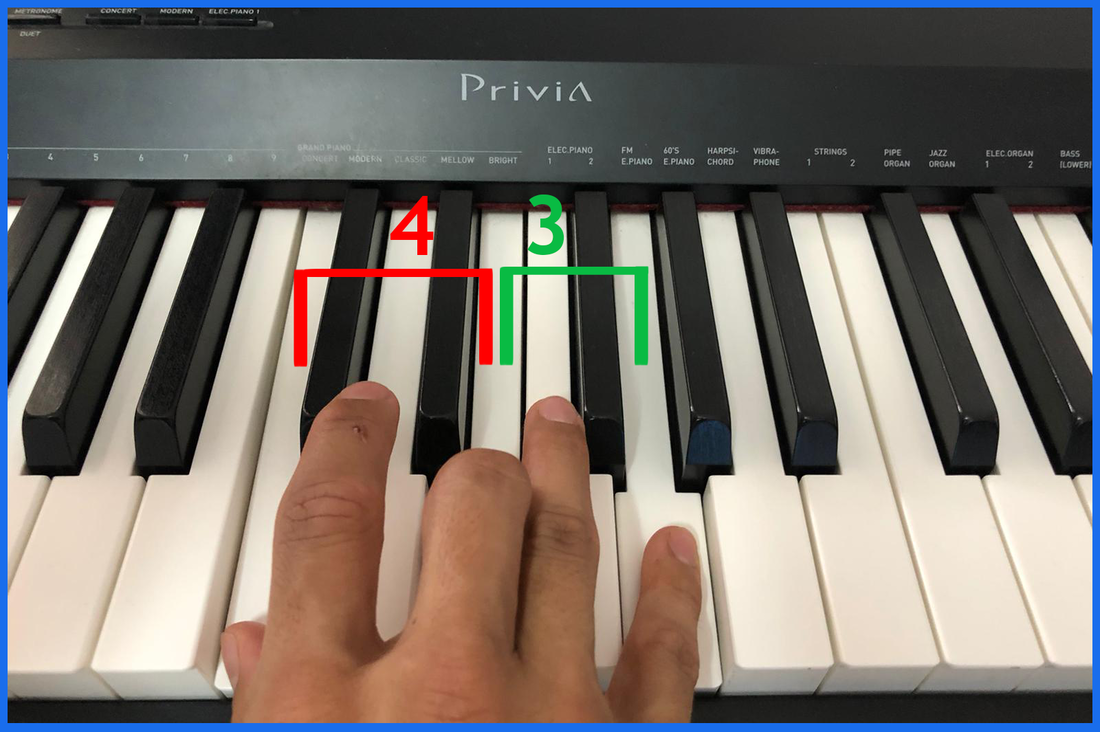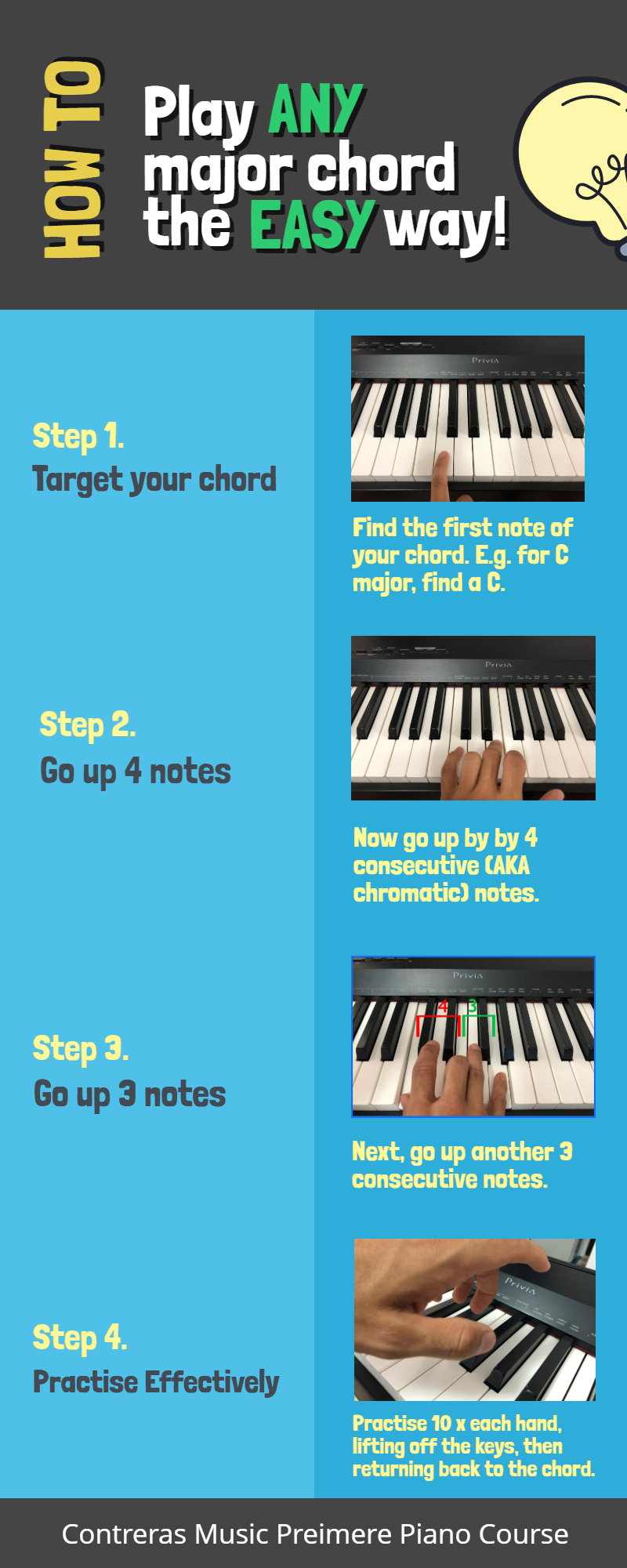| Download the free pdf |
Plain Text Version:
Arguably the worlds most recognised, loved, yet at times hated, piano song - Fur Elise by Beethoven. Whilst severe eye-rolling syndrome occurs at just the mention of that song, particularly for most piano teachers, musicians and pianists alike; there is actually much more to this piece than meets the eye. Its actual name is Beethoven's Bagatelle, No.25 in A minor, and the dedication on the original manuscript actually states 'Für Therese' (classicfm.com). Composed in 1810, the actual identity of the mystery lady still remains a mystery down to this day. Published some 40 years after the composer's death, this piece remained relatively obscure and ignored by the general public, and even by Beethoven himself (www.jstor.org/stable/24615621). Amazingly, this composition was completed despite Beethoven's progressive hearing loss (abc.net.au/classic), an amazing feat which could be illustrated by a painter who still creates a masterpiece despite being legally blind!
With all of that in mind, let's get on with the music. The iconic Bagatelle, or 'Fur Elise" piano piece is actually not as difficult to master as you might think; well, at least the sample melody isn’t. In fact, it is comprised of only three parts. Learn these three parts on the piano, and you will have yourself a new melody under your fingers, ready to show off the next time you play for someone. And since this is a Contreras music blitz piano lesson, I promise it's yours in under 3 minutes. For the full video tutorial, visit our Contreras music You Tube channel, and ContrerasMusic.Com to watch our online piano lessons for free!
Step one is correct hand positioning. This initial step is important since the correct fingering will either facilitate or hinder the melody. Start by placing your right hand one octave above middle C, then use finger five on E. Now prepare your fourth finger on the black key next to it, which is called D sharp. We will now practice a slow trill, which just means alternating between your fifth and fourth fingers on the D sharp and E. Practice this 10 to 20 times in order to get your fingers flowing smoothly with minimal wrist movement.
Next, place the second finger on B, the fourth finger on D, the third finger on C, and a thumb on A. Here is the order once again; B, D, C, A. Practice this movement over and over again, for at least 10 to 20 repetitions. Now put these two together. Start the trill on E and D sharp, repeat it twice, then play B, D, C and finish on an A. Repeat these two sections 10 to 20 times minimum.
Part two is based on ascending arpeggio shapes. This just means that the harmony is broken up into its chord tones which go up one after the other. The two cords or harmonies are A minor and E major. We begin by ascending on A minor using first finger on C, second finger on E, the fourth finger on A, and fifth finger on B. Next is the E Major shape. We go up starting from E with the first finger then G sharp using the second finger, then B with your fourth finger, and finish on C with your pinky. We now play solitary E with the thumb to re-start section one all over again like before. Again, be sure to practice these first two parts over and over, 10 to 20 times minimum, until you gain fluency.
Section 3 is simply a variation to part 2. We slightly change the second harmony into a descending scale. So instead of ascending on E, G#, B, and C as we did before, we will play E with the first finger, then C with our pinky, B with our fourth, and C with our third. So all up, it goes part one the main melody, part two the ascending arpeggios on A minor and E major, part 1 again, and part three is the variation or outro.
Apply the 10 to 20 times principal for your practice between each section. Remember that it may take you a few more repetitions, so don’t be afraid to spend as much time as you need in this section. Once you are ready, put all three parts together and practise that 10-20 times minimum. Don’t rush it, just focus on technique, not speed.
Congratulations, you can now play just like Beethoven using the right hand. For a more detailed lesson, including sheet music and practise tracks, visit ContrerasMusic.Com and be sure to check out PREMIERE PIANO, the best premium piano course for beginners. Its the most fun, engaging and professionally designed course out there, guaranteed to fast track your results on the piano.
With all of that in mind, let's get on with the music. The iconic Bagatelle, or 'Fur Elise" piano piece is actually not as difficult to master as you might think; well, at least the sample melody isn’t. In fact, it is comprised of only three parts. Learn these three parts on the piano, and you will have yourself a new melody under your fingers, ready to show off the next time you play for someone. And since this is a Contreras music blitz piano lesson, I promise it's yours in under 3 minutes. For the full video tutorial, visit our Contreras music You Tube channel, and ContrerasMusic.Com to watch our online piano lessons for free!
Step one is correct hand positioning. This initial step is important since the correct fingering will either facilitate or hinder the melody. Start by placing your right hand one octave above middle C, then use finger five on E. Now prepare your fourth finger on the black key next to it, which is called D sharp. We will now practice a slow trill, which just means alternating between your fifth and fourth fingers on the D sharp and E. Practice this 10 to 20 times in order to get your fingers flowing smoothly with minimal wrist movement.
Next, place the second finger on B, the fourth finger on D, the third finger on C, and a thumb on A. Here is the order once again; B, D, C, A. Practice this movement over and over again, for at least 10 to 20 repetitions. Now put these two together. Start the trill on E and D sharp, repeat it twice, then play B, D, C and finish on an A. Repeat these two sections 10 to 20 times minimum.
Part two is based on ascending arpeggio shapes. This just means that the harmony is broken up into its chord tones which go up one after the other. The two cords or harmonies are A minor and E major. We begin by ascending on A minor using first finger on C, second finger on E, the fourth finger on A, and fifth finger on B. Next is the E Major shape. We go up starting from E with the first finger then G sharp using the second finger, then B with your fourth finger, and finish on C with your pinky. We now play solitary E with the thumb to re-start section one all over again like before. Again, be sure to practice these first two parts over and over, 10 to 20 times minimum, until you gain fluency.
Section 3 is simply a variation to part 2. We slightly change the second harmony into a descending scale. So instead of ascending on E, G#, B, and C as we did before, we will play E with the first finger, then C with our pinky, B with our fourth, and C with our third. So all up, it goes part one the main melody, part two the ascending arpeggios on A minor and E major, part 1 again, and part three is the variation or outro.
Apply the 10 to 20 times principal for your practice between each section. Remember that it may take you a few more repetitions, so don’t be afraid to spend as much time as you need in this section. Once you are ready, put all three parts together and practise that 10-20 times minimum. Don’t rush it, just focus on technique, not speed.
Congratulations, you can now play just like Beethoven using the right hand. For a more detailed lesson, including sheet music and practise tracks, visit ContrerasMusic.Com and be sure to check out PREMIERE PIANO, the best premium piano course for beginners. Its the most fun, engaging and professionally designed course out there, guaranteed to fast track your results on the piano.




 RSS Feed
RSS Feed
